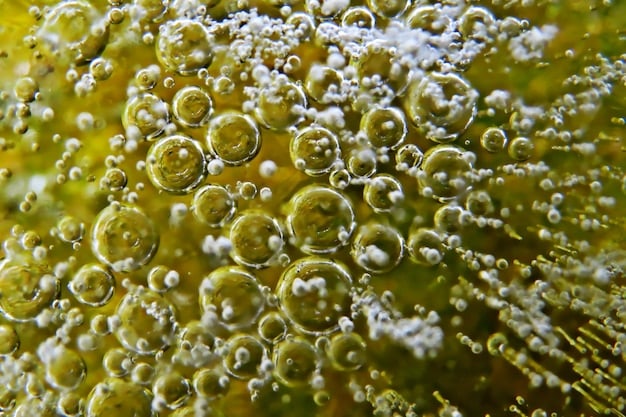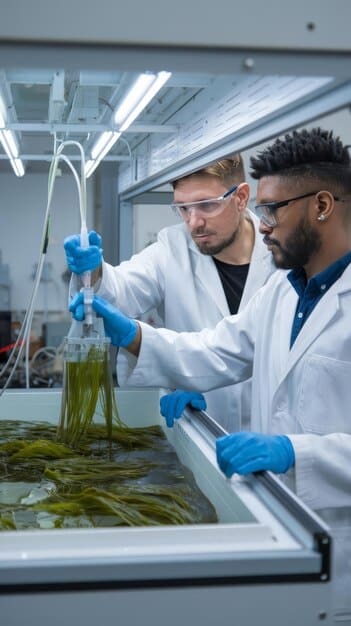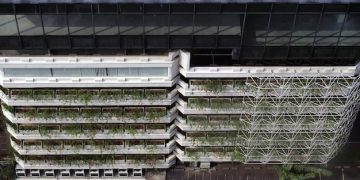Algae Biofuels: Breakthroughs and Commercialization Prospects in the US

Understanding the potential of algae biofuels involves examining recent scientific advancements and the economic viability of large-scale production in the United States, addressing sustainability, efficiency, and scalability challenges.
The quest for sustainable energy sources has led researchers and investors to explore various alternatives, with understanding the potential of algae biofuels emerging as a promising frontier in the US. This article delves into recent breakthroughs, challenges, and commercialization prospects.
Exploring Algae Biofuels: An Introduction
Algae biofuels have garnered attention as a potential game-changer in renewable energy. Unlike traditional biofuels that compete with food crops for land, algae can be cultivated in non-arable areas, utilizing wastewater and even capturing carbon dioxide. This introduction sets the stage for examining the advancements and viability of algae biofuels.
What Are Algae Biofuels?
Algae biofuels are biofuels derived from algae biomass. Algae, diverse and rapidly growing microorganisms, naturally produce lipids (oils) that can be converted into biodiesel, bio-jet fuel, and other valuable biofuels.
Advantages Over Traditional Biofuels
Compared to traditional biofuels like ethanol and biodiesel from corn and soybeans, algae biofuels offer several advantages, including higher yields per acre, non-competition with food crops, and the ability to grow in diverse environmental conditions.
- Higher lipid content compared to other biofuel feedstocks.
- Reduced dependence on arable land and freshwater resources.
- Potential to capture CO2 from industrial sources, mitigating greenhouse gas emissions.
Algae biofuels represent a promising avenue towards sustainable and environmentally friendly energy production, addressing the limitations of conventional biofuel sources.

Recent Scientific Breakthroughs in Algae Biofuel Production
Recent years have witnessed significant scientific breakthroughs that are paving the way for efficient and cost-effective algae biofuel production. These advancements range from genetic engineering to novel cultivation techniques, all aimed at optimizing lipid yields and reducing production costs.
Genetic Engineering for Enhanced Lipid Production
Genetic engineering plays a pivotal role in enhancing the lipid production capabilities of algae strains. Researchers are identifying and modifying genes that regulate lipid synthesis, accumulation, and metabolic pathways to maximize oil yields.
Optimized Cultivation Techniques
Innovative cultivation techniques are being developed to enhance algae growth, productivity, and lipid accumulation. These techniques include photobioreactors, open pond systems, and integrated cultivation systems that utilize wastewater and nutrient recycling.
- Advanced photobioreactor designs for enhanced light penetration and CO2 utilization.
- Nutrient recycling strategies to minimize waste and reduce operational costs.
- Integration of algae cultivation with wastewater treatment for resource recovery.
These breakthroughs are essential for unlocking the full potential of algae as a sustainable biofuel feedstock and improving the overall economics of algae biofuel production.
Commercialization Prospects in the US: A Landscape Analysis
The commercialization of algae biofuels in the US presents a complex landscape influenced by technological advancements, economic factors, and regulatory frameworks. Understanding these prospects is crucial for investors, policymakers, and stakeholders interested in the growth of the algae biofuel industry.
Pilot Projects and Demonstration Plants
Several pilot projects and demonstration plants have been established across the US to evaluate the feasibility and scalability of algae biofuel production. These initiatives provide valuable insights into operational challenges, technology performance, and economic viability.
Economic Viability and Cost Reduction Strategies
Economic viability remains a significant hurdle for large-scale algae biofuel production. Cost reduction strategies, including optimizing cultivation techniques, utilizing waste resources, and developing efficient extraction methods, are essential for achieving competitive pricing.
- Technological advancements in algae harvesting and lipid extraction.
- Scale-up strategies to reduce capital and operational expenses.
- Market analysis and identification of niche applications for algae biofuels.

Challenges Facing Algae Biofuel Commercialization
While algae biofuels hold tremendous potential, several challenges must be addressed to enable widespread commercialization. Overcoming these hurdles will be critical for unlocking the full potential of algae biofuels as a sustainable energy source.
Technological Hurdles
Technological challenges include enhancing lipid yields, optimizing cultivation techniques, and developing cost-effective harvesting and extraction methods. Breakthroughs in these areas are necessary for improving the overall efficiency and economics of algae biofuel production.
Economic Barriers
Economic barriers encompass high capital and operational costs, market competitiveness with fossil fuels, and the need for government subsidies and incentives. Addressing these barriers requires innovative financing models, optimized production processes, and supportive regulatory policies.
Environmental Considerations and Sustainability
Ensuring the environmental sustainability of algae biofuel production is paramount. Considerations include minimizing water usage, preventing nutrient pollution, and assessing the overall carbon footprint of algae biofuel production.
US Government Initiatives and Policies Supporting Algae Biofuels
The US government plays a crucial role in supporting the development and commercialization of algae biofuels through various initiatives and policies. These efforts aim to stimulate research, promote innovation, and create a favorable regulatory environment.
Research and Development Funding
Government agencies, such as the Department of Energy (DOE) and the National Science Foundation (NSF), provide funding for research and development projects focused on algae biofuel technologies. These investments drive innovation and accelerate the pace of scientific discovery.
Regulatory Frameworks and Incentives
Regulatory frameworks and incentives, including tax credits, grants, and loan guarantees, are designed to support the production and consumption of algae biofuels. These policies incentivize investment and promote the adoption of sustainable energy practices.
Public-Private Partnerships
Public-private partnerships facilitate collaboration between government agencies, research institutions, and private companies. These partnerships leverage resources, expertise, and infrastructure to advance the commercialization of algae biofuels.
Future Trends and Outlook for Algae Biofuels in the US
The future of algae biofuels in the US is promising, with several key trends and developments expected to shape the industry in the coming years. These trends include technological advancements, market expansion, and policy support, collectively driving the growth and sustainability of algae biofuels.
Integration with Wastewater Treatment Facilities
Integrating algae cultivation with wastewater treatment facilities offers synergistic benefits, including nutrient recovery, wastewater purification, and biofuel production. This approach enhances resource efficiency and reduces environmental impacts.
Wastewater provides essential nutrients for algae growth, reducing the need for synthetic fertilizers.
- Algae cultivation helps remove pollutants and contaminants from wastewater.
- Biomass produced during wastewater treatment can be converted into biofuels.
Advanced Biofuel Technologies and Biorefineries
Advanced biofuel technologies and biorefineries are being developed to convert algae biomass into a range of valuable products, including biofuels, bioplastics, and nutraceuticals. This integrated approach enhances economic viability and promotes a circular economy.
Advanced biofuel technologies optimize the conversion of algae biomass into high-value products.
Biorefineries enable the co-production of biofuels, bioplastics, and other bio-based materials.
| Key Point | Brief Description |
|---|---|
| 🌱 Algae’s Potential | Algae biofuel offers high yields and doesn’t compete with food crops. |
| 🔬 Breakthroughs | Advancements include genetic engineering and optimized farming techniques. |
| 💰 Commercialization | Pilot projects are testing feasibility, but costs need to be reduced. |
| 🤝 US Support | Government initiatives fund research and offer incentives. |
Frequently Asked Questions
▼
Algae offer high lipid yields compared to other biofuel feedstocks and can be cultivated without competing with food crops. Additionally, they can utilize wastewater and capture CO2, enhancing sustainability.
▼
The primary challenges include high production costs, technological hurdles in optimizing lipid yields, and the need for efficient harvesting and extraction methods to make algae biofuels economically viable.
▼
The US government supports algae biofuel development through research funding, regulatory frameworks, incentives such as tax credits and grants, and public-private partnerships aimed at advancing technology commercialization.
▼
Environmental considerations involve minimizing water usage, preventing nutrient pollution, and assessing the overall carbon footprint of algae biofuel production to ensure sustainable and eco-friendly practices are implemented.
▼
Future trends include the integration of algae cultivation with wastewater treatment facilities, advancements in biofuel technologies, and the development of biorefineries that produce a range of valuable products, enhancing economic viability.
Conclusion
Understanding the potential of algae biofuels in the US requires recognizing recent advancements and confronting existing challenges. With ongoing research, government support, and technological developments, algae biofuels hold promise as a sustainable energy source, contributing to a more environmentally friendly future.





